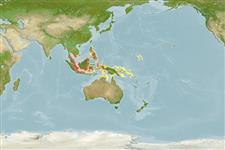Common names from other countries
Environment: milieu / climate zone / depth range / distribution range
экология
ассоциированный с рифами. Tropical
Western Central Pacific: throughout Southeast Asia, reaching the Philippines.
Length at first maturity / Size / Вес / Возраст
Maturity: Lm ? range ? - ? cm Max length : 10.0 cm CW самец/пол неопределен; (Ref. )
Carapace ovate, covered with numerous very small granules; regions well defined; 4 broad lobiform teeth on each anterolateral margin. Eyes green in life. A larger molariform tooth at base of movable finger of larger chela. Carapace dirty-brown overall; eyes green, fingers black.
Occurs from shallow water to intertidal zones. Inhabits mangrove areas and prefers rocky areas, or areas densely covered by bivalves, such as Perna spp. Benthic. Tropical climate (Ref. 343).
Life cycle and mating behavior
половая зрелость | размножение | нерест | икра | Fecundity | личинки
Members of the order Decapoda are mostly gonochoric. Mating behavior: Precopulatory courtship ritual is common (through olfactory and tactile cues); usually indirect sperm transfer.
Основная ссылка
ссылки | координатор | соавторы
Ng, P.K.L. 1998. (Ref. 343)
Статус Красного Списка МСОП (Ref. 130435)
Статус СИТЕС (Ref. 108899)
Not Evaluated
Not Evaluated
Угроза для людей
Harmless
Использование человеком
| FishSource |
инструменты
дополнительная информация
Возраст/РазмерыростЗависимость между длиной и массой телаЗависимость между длинамиморфологияличинкичисленность
ресурсы в Интернет
Estimates based on models
Уязвимость
Low vulnerability (10 of 100).
Категория цены
Unknown.
